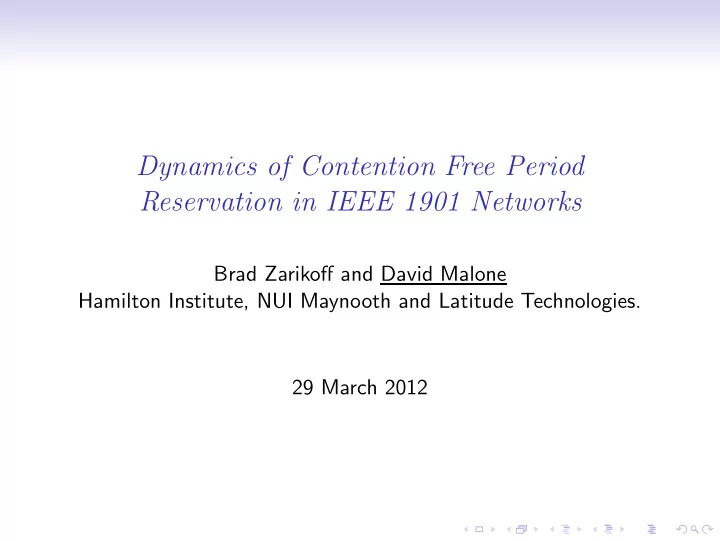

Dynamics of Contention Free Period Reservation in IEEE 1901 Networks Brad Zarikoff and David Malone Hamilton Institute, NUI Maynooth and Latitude Technologies. 29 March 2012
Overview • IEEE 1901, broadband, in-home. • Options for contention-based and contention-free access. • Contention part looks like WiFi. • Contention free arises from previous work 12 • Good for traffic with QoS requirements? 1 H. Hrasnica and R. Lehnert, Reservation Domains in MAC Protocols for Broadband PLC Networks, ISPLC 2005. 2 Y.-J. Lin, H. A. Latchman, J. C. L. Liu, and R. Newman, Periodic Contention-Free Multiple Access for Broadband Multimedia Powerline Communication Networks, ISPLC 2005.
Contention Free Access B CFP CAP B CFP For each flow wanting to use CFP: • Station must make request to BSS manager in CAP. • BSS manager must update CFP schedule. • Schedule is announced by BSS manager in beacons. • Station begins use of CFP, until reservation is canceled. Schedules are transmitted with a lifetime; to expire a schedule you must wait for the lifetime CSCD (= M frames) and transmit a preview of the new schedule.
Sources Reservation of Delay • Contending for access (backoff, collisions, ACKs, etc.). • Waiting for preview schedule to become current. • Waiting for modification to current schedule. Has to be repeated if reservation is canceled. • BSS manager can cancel the reservation. • The station can request the cancellation. • There is an inactivity limit ( T il ).
Setup • Focus on reservation delay. • Simulate with discrete event simulator. • N stations making reservations. • Run with beacon interval of 40ms for 80s (2000 intervals). • Start with defaults of T CAP = 4ms and M = 3. 1 0.8 Success Success Success Failure Signals 0.6 0.4 0.2 Back-off Slots 0 0 0.5 1.0 1.5 2.0 2.5 3.0 3.5 4.0 Time (ms)
Saturated Traffic 1400 M = 7 M = 3 1200 M = 1 1000 800 E [ d ] (ms) 600 400 320 200 160 80 0 0 10 20 30 40 50 N
How big should CAP be? 2.0 N = 50 N = 10 N = 5 1.6 1.2 E [ d ] (s) 0.8 0.4 0 1 2 3 4 5 6 7 8 9 10 T CAP (ms)
How about voice? • Saturated traffic won’t time out, delay is one off. • Saturated traffic usually not too delay sensitive. • How about voice? • Simple model, 64kbps, on-off exponential mean 1.5 with talk clamped below at 240ms 3 . • Note, delay budget on the order of a few frames. 3 A. P. Markopoulou, F. A. Tobagi, and M. J. Karam, Assessing the quality of voice communications over internet backbones, IEEE/ACM ToN, vol. 11, no. 5, 2003.
Saturated vs. Voice with long timeout 1400 1400 M = 7 M = 7 M = 3 M = 3 1200 1200 M = 1 M = 1 1000 1000 E [ d ] (s) 800 E [ d ] (s) 800 600 600 400 400 320 320 200 200 160 160 80 80 0 0 0 10 20 30 40 50 0 10 20 30 40 50 T CAP (ms) T CAP (ms) Saturated Voice Really measuring setup. How about with more realistic timeouts?
How big should T il be? 216 18e3 N = 50 16e3 208 N = 2 14e3 200 12e3 192 E [ d ] (ms) 10e3 E [ E ] 184 8e3 176 6e3 168 4e3 160 2e3 0 160 320 480 160 320 480 T il (ms) T il (ms) Delay Timeouts M = 3, T CAP = 40 ms
Mixed Saturated and Voice Saturated would usually live in contention period. 4.5 480 N bg = 0 N bg = 4 N bg = 8 N = 50 4.4 N bg = 2 400 N bg = 6 N = 20 N bg = 10 N = 8 320 4.3 N = 2 240 4.2 E [ d ] (ms) 160 MOS 4.1 480 4 400 3.9 320 3.8 240 160 3.7 0 2 4 6 8 10 0 10 20 30 40 50 N N bg Delay E-Model MOS MOS: 4.34 Very satisfied; 4.03 Satisfied; 3.60 Some users dissatisfied.
Conclusion • Contention-free access looks useful. • Reservation delays can be significant. • Use small M if possible. • Use long T il if possible. • Careful use of prioritisation may help. • Matching application may help.
Recommend
More recommend